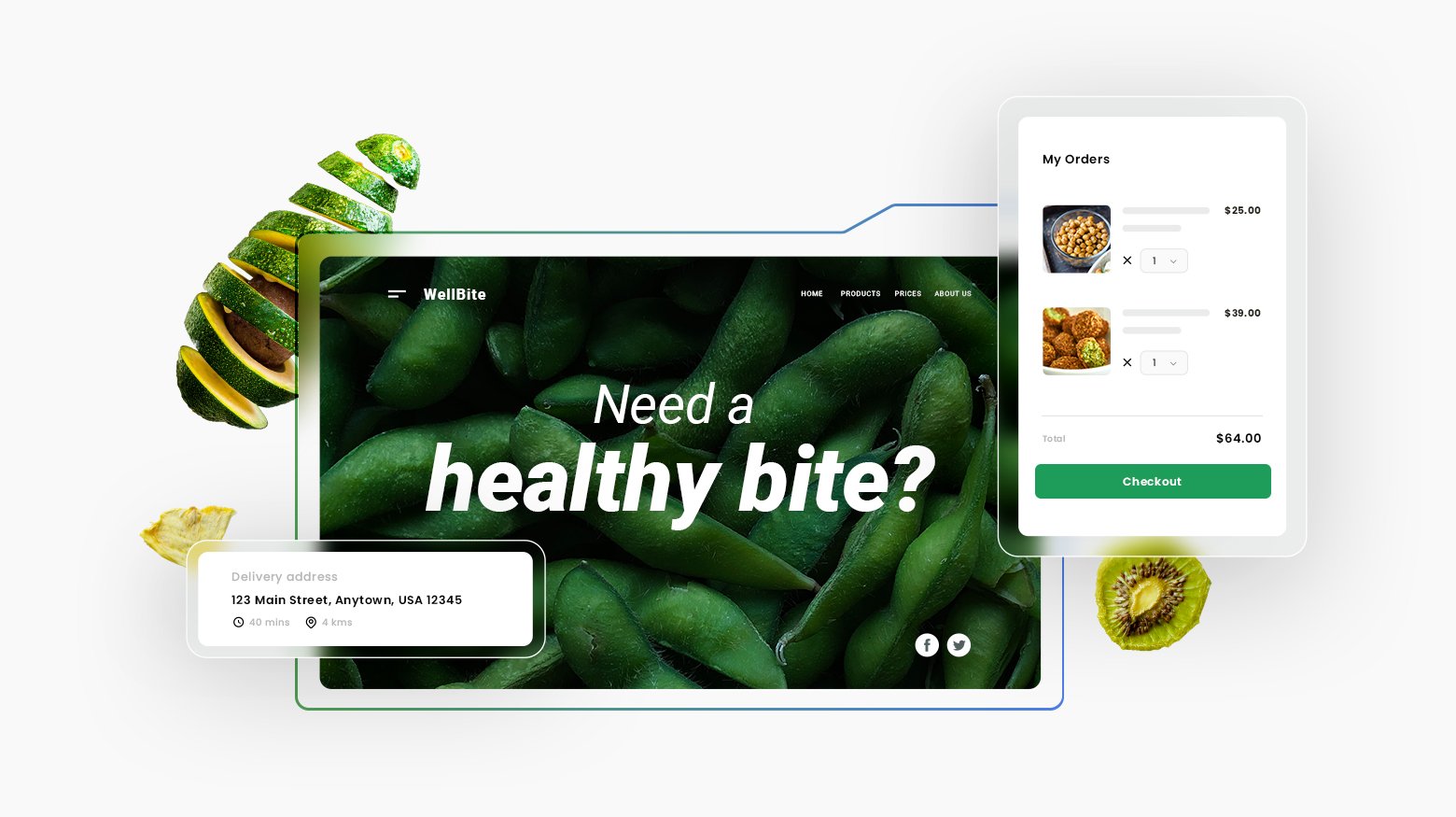It’s hard to identify what successful affiliate marketing websites look like. Not the big-budget, corporate ones, but the real sites run by entrepreneurs, bloggers, and creators. That’s what this guide is all about. We’ve gathered some of the most interesting, effective, and even unexpected affiliate marketing website examples to break down how they work:
- What niche they picked (and why)
- How they structure their content and affiliate links
- What tools or strategies they’re using to grow traffic and build trust
- What you can learn and apply to your own site
As you explore these examples, you’ll start to see the patterns: what works, why it works, and how to use those insights for your own project. Let’s spark some new ideas for your own affiliate project and see how you can build your own site with AI tools!
8 successful affiliate marketing website examples
Without further ado, let’s start by breaking down 8 real affiliate marketing website examples and analysing how each one makes money, builds trust, and earns clicks. Borrow their best ideas, skip their mistakes.
1. Minimalist Baker

What we like the most about this affiliate marketing website:
- Clean visual layout
- Recipe-focused navigation
- Trust-building elements
Minimalist Baker chose a smart niche – simple, plant-based recipes – which has broad appeal and high search volume. Content is tightly aligned with intent: quick recipes, seasonal roundups, and top picks all build trust without overwhelming with too much information. They also weave in monetization through a shop and digital product, but in a way that feels like a helpful next step rather than a sales push. If you’re building a content-first affiliate site, this is a great model.
2. This Is Why I’m Broke

What we like the most about this affiliate marketing website:
- Distinct content strategy
- Skimmable product grid
- Viral shareability baked in
This Is Why I’m Broke is a reminder that not all successful affiliate marketing websites are “pretty,” and they don’t have to be. This isn’t the slickest design on the internet, but it works because it’s clear, consistent, and instantly delivers value. We’ll dig into this idea later in the article, but this example breaks the stereotype that earning online requires glossy design. What matters more is structure, navigation, and a simple, repeatable concept.
3. PCPartPicker
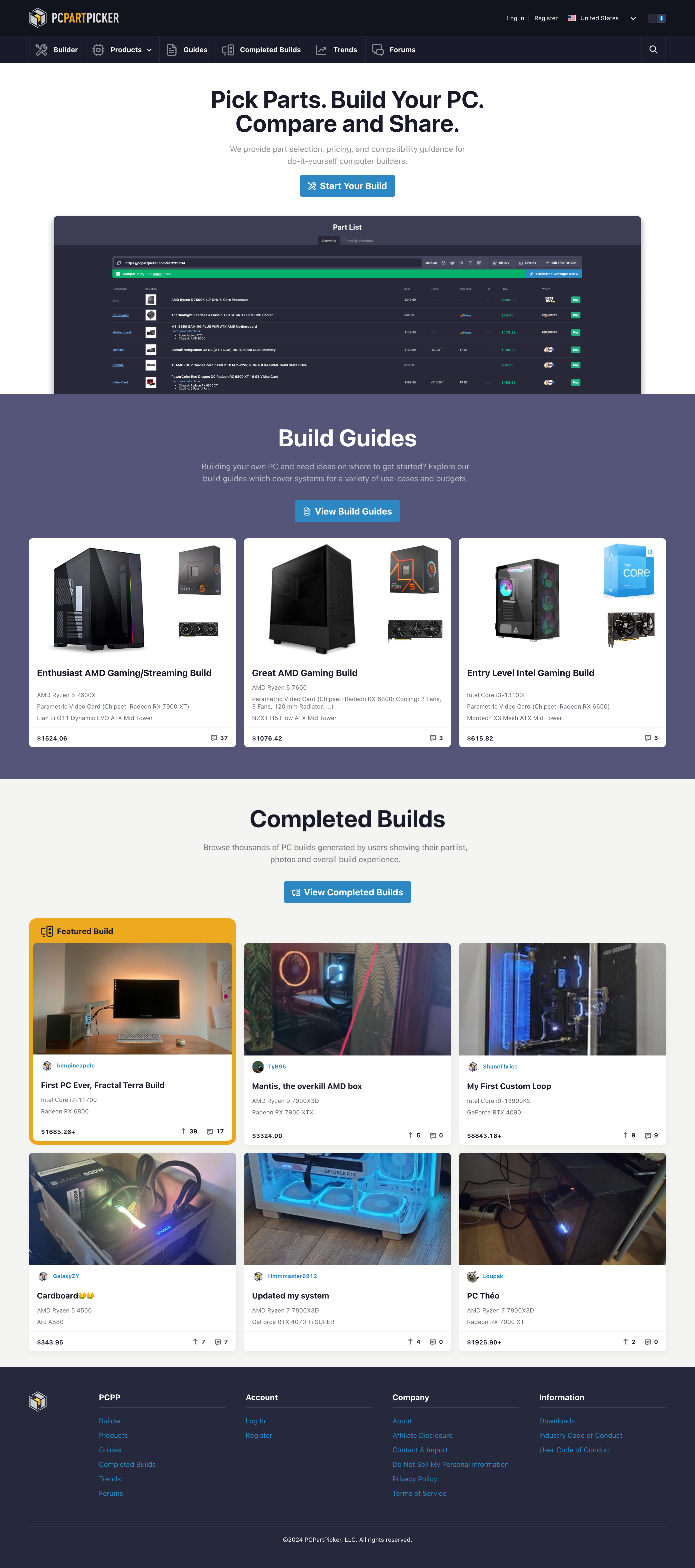
What we like the most about this affiliate marketing website:
- Interactive comparison tool
- Community build sharing
- Built-in buyer guidance
PCPartPicker isn’t a regular review site but a full-on playground for PC nerds. This niche is clear: helping DIY builders pick compatible parts and see real-world builds. What makes this one of the most unique affiliate marketing website examples is that the PC-assembling tool itself serves as both the main traffic driver and the core source of value. You’re not just reading reviews, but using their builder, guides, and part lists to make confident purchases, all while clicking through affiliate links.
4. The Points Guy

What we like the most about this affiliate marketing website:
- Reward card comparisons
- Points-to-dollar calculators
- News meets how-tos
You know that one friend who always flies first class on points and somehow gets airport lounge access for free? The Points Guy is that friend, only smarter, faster, and with way more spreadsheets. It’s built around a high-paying niche, credit cards and travel rewards, which means each affiliate click can be worth a lot.
But what makes this one of the most successful affiliate website examples isn’t just the niche; it’s the mix of timely news, detailed guides, and tools that help readers understand and use their points better. If you’re aiming for high-value conversions with strong editorial content, you can also look at other travel blog examples and how they monetize themselves.
5. TechRadar

What we like the most about this affiliate marketing website:
- Deep product coverage
- High-volume content flow
- Trusted editorial voice
If you’ve ever Googled “best laptop for students” or “iPhone 16 review,” chances are you’ve landed on TechRadar. It’s one of those successful affiliate marketing websites that dominates because they show up everywhere, but never feels spammy.
The site covers a huge range of categories, but the structure keeps it clear: reviews, comparisons, and trending deals are all easy to find. They earn through well-placed links and smart seasonal content, but what really stands out is how much trust the editorial tone builds. For affiliate marketers thinking big, with SEO as the engine, TechRadar is a model worth dissecting.
6. Finder
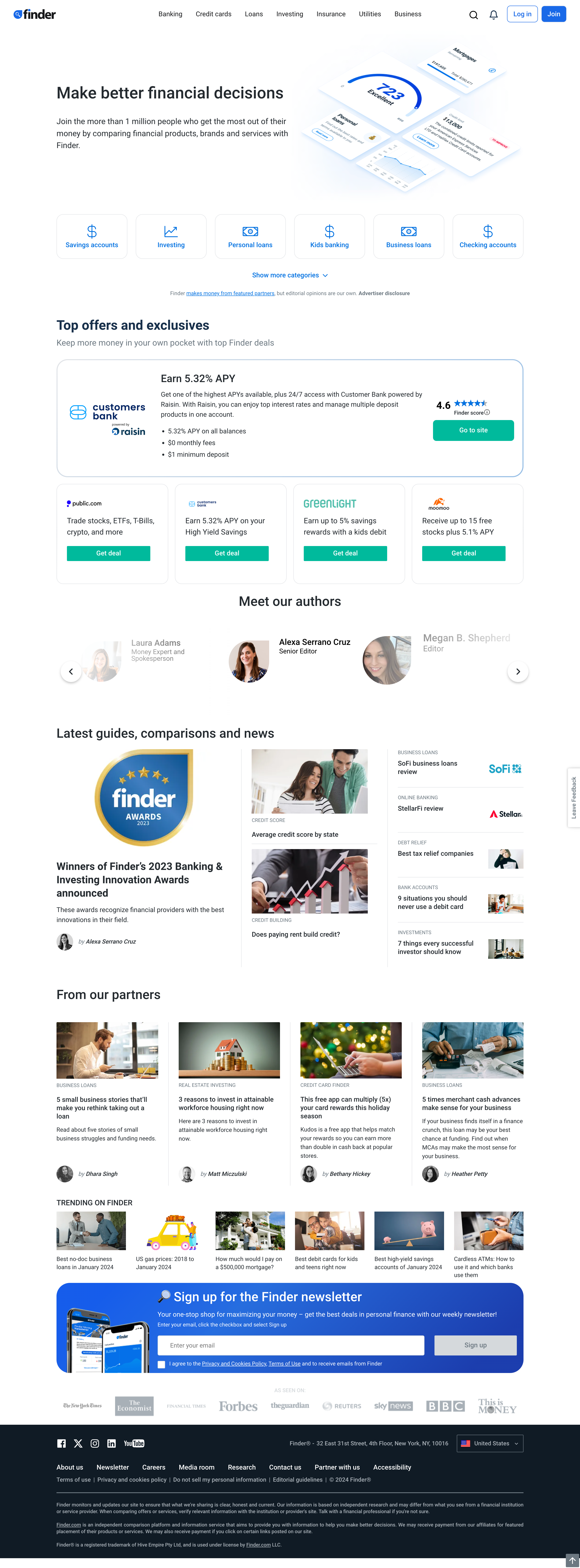
What we like the most about this affiliate marketing website:
- Buttons everywhere you need them
- Super easy navigation
- Trust built right in
The key to Finder’s success is its simplicity. The moment you land, you see offers with buttons that take you straight to the deal. They don’t bury links at the bottom. They’re right at the top, making it super easy to take action. The left-hand sidebar lets you jump between sections and find exactly what you’re looking for. And when it comes to trust, they’re one of the best affiliate marketing website examples that go all in: real author faces, clear ratings, and even stats showing how many people use their site.
7. Skyscanner
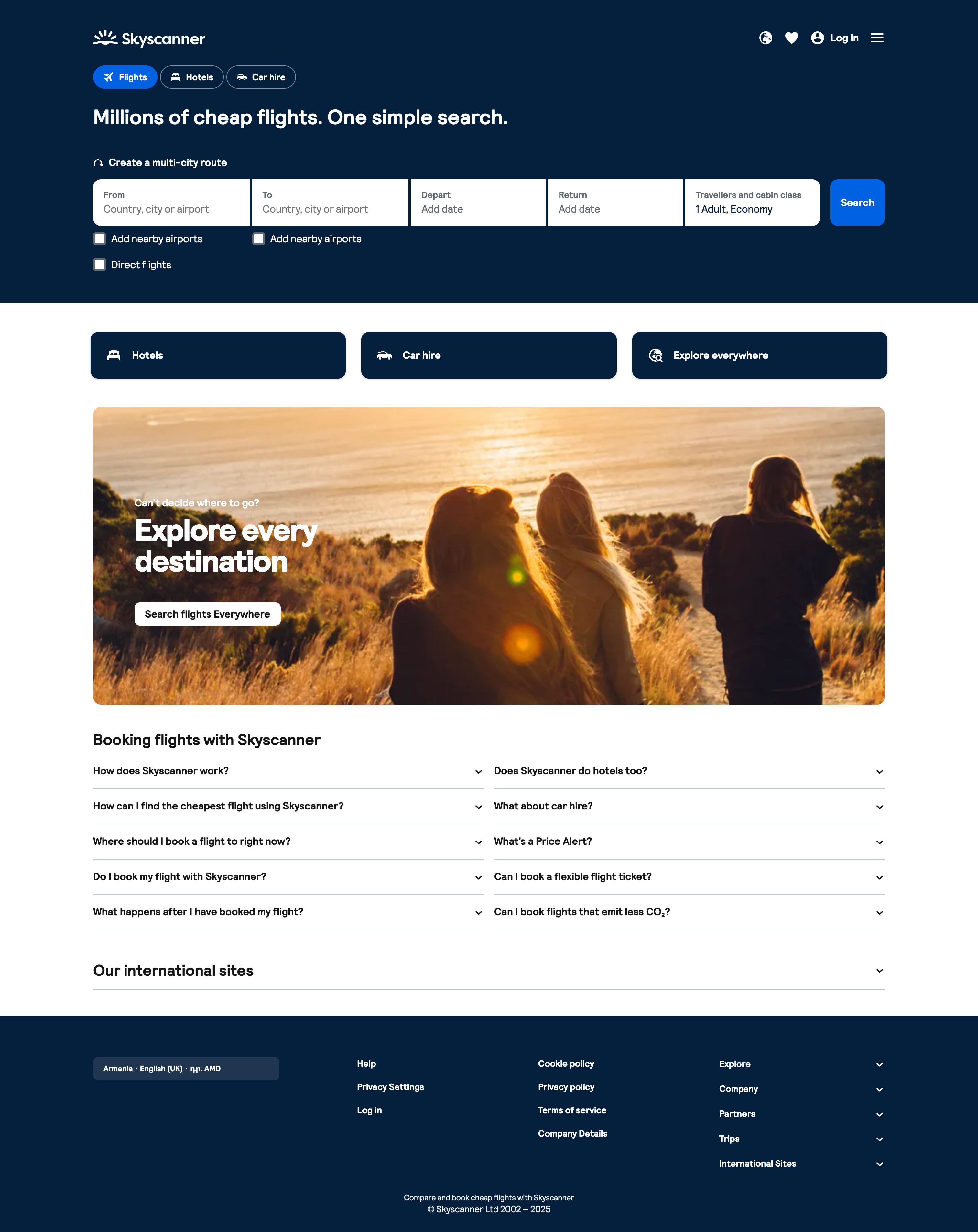
What we like the most about this affiliate marketing website:
- Instant search functionality
- Ultra-clear layout
- Trust through usefulness
Skyscanner is probably the most familiar name on this list. If you’ve ever searched for cheaper flights, you’ve landed here. And that’s the point: it works because it’s helpful. From the very first screen, you can start searching, comparing, and planning without clicking around or getting lost. It’s not trying to “convert” you. It’s trying to be useful, and that’s exactly what makes it convert. If your affiliate marketing website is structured around helping your audience (not just grabbing clicks), this is a great one to study.
8. Dog Food Advisor
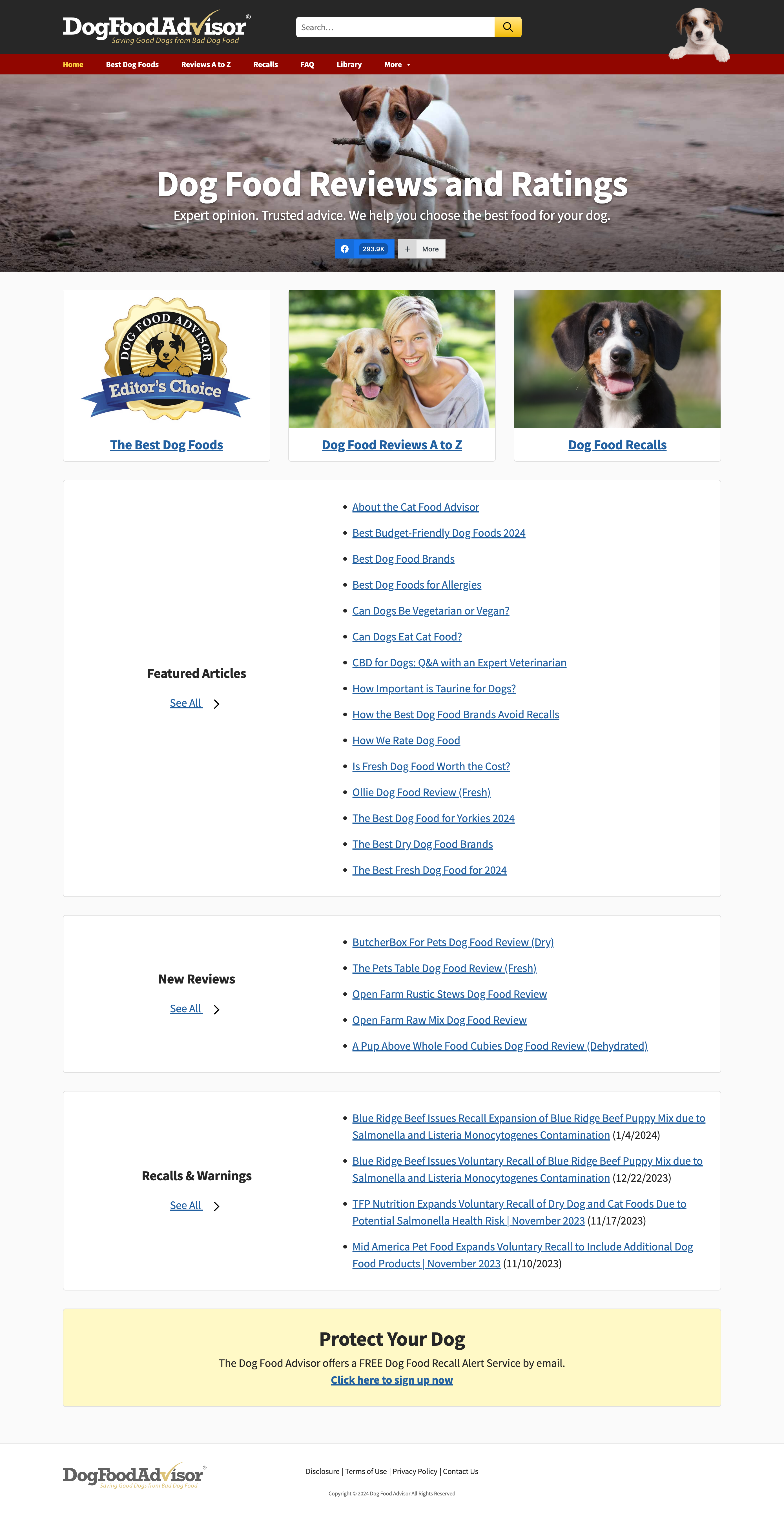
What we like the most about this affiliate marketing website:
- Super clear categories
- Review-focused structure
- Built-in trust through layout
Dog Food Advisor is built for usability – everything’s neatly organized into “Best Dry Dog Foods,” “Budget-Friendly,” “Recalls,” and more. That means if you’re a dog owner looking for something specific, you can find it fast. And that’s the lesson here: if a visitor lands on your site and doesn’t know where to click, they’ll bounce, and you’ll lose that commission. Dog Food Advisor shows that helpful layout, clear categories, and trust-driven content is what turns traffic into revenue.
Create your dream website with 10Web AI Website Builder 
Build your website in 1 minute
and take your business online!
How to create an affiliate marketing website
You’ve seen affiliate marketing website examples, you’ve busted the myths. Now let’s talk about how to actually build your affiliate site so it works for both visitors and revenue. You don’t need anything fancy to start, but you do need a clear structure, the right tools, and a few smart choices up front.
Your affiliate site – done in minutes with AI
Choosing a layout, figuring out what pages you need, styling everything is a lot, especially if you’re not a designer or developer. That’s where choosing the right tools can save you time (and money). One of these tools is 10Web AI Website Builder.
Instead of starting from scratch, you just describe your site, and the AI builds the whole thing for you. Seriously, it’s like saying, “I’m starting a blog that reviews running shoes,” and watching your homepage, review pages, and even the blog layout appear in minutes:
- Describe your site: Share what your site is about, what pages you want, and a few style preferences.
- Let AI do the building: You’ll get a clean, fully structured website with all the essential sections (homepage, product roundups, even disclosures).
- Make it yours: Edit colors, fonts, pages, or layouts.
Later if you want to move a section, add a page, or do any other edits, just type what you want, and 10Web’s AI Co-Pilot makes it happen.
Bonus: The structure AI creates is already optimized for affiliate sites with clean navigation, content-focused layout, and sections designed to convert. So you’re not just saving time, you’re getting a better starting point.
Extra tips to optimize your affiliate site
Even with AI doing most of the setup, there are a few simple alterations you can make to turn a good site into a great one, especially when it comes to how your content flows and where your links go.
In terms of website structure, start with just a few core pages:
- A homepage with a quick intro and helpful content links
- A product roundup (e.g. “Best standing desks for home offices”)
- A single-product review or comparison table
- A FAQ or blog post to pull in search traffic
10Web sets up this layout by default, so you’re already ahead, but you still can make any changes you want. Just don’t overthink design and try to stay clean.
Before talking about affiliate links, let us mention that you can use internal linking in your blog posts to your main roundup/review pages. This will boost both SEO and conversions. As for the affiliate links, skip the buried bottom-of-the-page links. Instead:
- Add links in context with your recommendations
- Use buttons or comparison tables for visibility
- Put your top picks above the fold, especially in roundups
Create your dream website with 10Web AI Website Builder 
Build your website in 1 minute
and take your business online!
Want to promote top-tier tech tools with real demand?
Not every great affiliate website is a blog or product review site. Some are businesses that run their own affiliate programs. If you’re more on the tech side and looking for solid programs to partner with, check out the 10Web’s Affiliate Program.
10Web is a trusted platform used by over 1.5 million websites and now offers a powerful AI Website Builder API that agencies, SaaS platforms, and devs can promote. As an affiliate, you earn 30% recurring commission for 12 months on every referral, plus you get marketing assets, tracking via Impact, and a dedicated support team. If your audience is into WordPress, automation, or AI tools, this is a great offer to include on your site.
What beginners get wrong
If you’ve ever stared at your half-finished affiliate site and thought, “This can’t possibly work…” – you’re in the right section. A lot of affiliate marketers (especially in the early days) get stuck because of a few stubborn myths. Let’s clear those up right now so you can move forward with less pressure and more confidence.
1. You need a full blog to make money
So do I need to write like 50 articles before I can even make $10?
No. Some of the most profitable affiliate sites are just one landing page with a product comparison, or a five-page niche site with great internal linking. Having a massive content machine is not needed. You can start small and focus on one or two high-quality pages like a product roundup, in-depth guide, or comparison chart. Then expand as you see traction.
2. Only pretty, professional sites make money
I saw a site that looked like it was made in 2009… but it ranked above mine.
This one is frustrating. Yes, good design helps with trust, but it doesn’t necessarily lead to profit. Some high-converting affiliate websites look barebones, even outdated. What they get right is clear structure, fast load speed, and focused content. So, prioritise clarity over beauty, and make sure your offer is obvious.
3. You need to be on every affiliate network
If you’re trying to juggle Amazon, ClickBank, ShareASale, CJ, Impact, and half a dozen more, just don’t. That’s how people burn out. Pick one or two programs that match your niche. Focus on content and conversion first. You can always branch out later.
Ready to build your own?
You’ve just seen what real affiliate success looks like across niches, styles, and strategies. The affiliate marketing website examples we’ve reviewed are different, but there is a pattern: clear structure, valuable content, smart monetization, and a setup that works for your goals.
You don’t have to build it all by hand. With tools like 10Web AI Website Builder, you can go from idea to affiliate-ready site in minutes without coding. Start small. Focus on helping your readers. Don’t wait for “perfect” and start building now.
Create your dream website with 10Web AI Website Builder 
Build your website in 1 minute
and take your business online!
FAQ
Can you make $100 a day with affiliate marketing? How do I start an affiliate marketing website? Do affiliate websites make money? What is the highest paying affiliate website? What does an Amazon affiliate site look like? How do you structure product reviews or blog content? Do you need a full blog, or can you succeed with one landing page? What’s the best affiliate network to start with? How do I integrate links without being too salesy? What tools or themes are used to build these sites? How do these sites get traffic—SEO, social, or paid? What’s the best structure for conversions? How many pages or posts do these big sites usually have? How do I break into saturated niches or competitive programs (like Amazon)? What’s the ROI of product aggregators vs. blogs?
Create your dream website with 10Web AI Website Builder 
Build your website in 1 minute
and take your business online!









